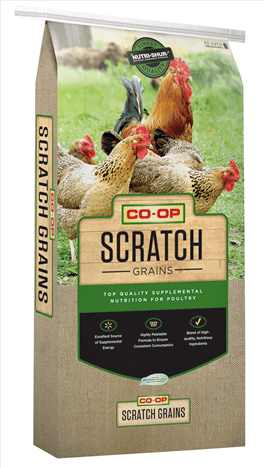What is chicken scratch exactly?
Sep 16, 2019

So, what is chicken scratch exactly? As its name implies it is something that chickens will scratch around in the dirt and bedding to find and eat.
The mixture is normally made of several types of whole grains. The usual ingredients included in scratch are cracked or rolled corn, barley, oats, wheat, sunflower seeds, milo, and millet. How much of each and how many grains included will depend on formulation. Scratch with more grain types, such as a 5-grain scratch, will cost a bit more than ones with fewer grain types like 2-grain scratch.
On the other hand chicken feed is scientifically formulated to give chickens the exact amounts of nutrients they need based on age and type (chick vs. hen or egg layer vs. meat bird).
For example, a 16% layer feed will provide 16% crude protein, the amount necessary for continued health and egg laying. Fiber and fat content may vary slightly based on the manufacturer’s formulation.
In addition to corn, soybean, and wheat grains, feeds will contain a wide variety of trace elements such as selenium, copper sulfate, and ferrous sulfate, as well as vital amino acids such as methionine. They will also be supplemented with a large variety of vitamins and, of course, calcium carbonate for shell making.
In these modern times, scratch is fed as a treat because it lacks wholesome nutritional substance, providing 8 to 9% protein, which is vastly inferior to a complete ration.
Think of it this way:
Good balance to your hens’ diet is essential if you want to keep them healthy and laying. If a hen has a diet that does not cover her nutritional needs, the first thing you’ll notice is that she will she stop laying, or the eggs will be soft shelled or shell-less.
By all means give them treats if you want, but in small amounts and preferably not every day. Any treats that you give your hens should not exceed 10% of their daily intake. Scratch feeds can be used as a reward for being good they will come to you time and time again.
Co-op offers a complete line of chicken feeds to meet most any poultry flock. Contact your local Co-op livestock experts for a recommendation that fit your specific needs.
The mixture is normally made of several types of whole grains. The usual ingredients included in scratch are cracked or rolled corn, barley, oats, wheat, sunflower seeds, milo, and millet. How much of each and how many grains included will depend on formulation. Scratch with more grain types, such as a 5-grain scratch, will cost a bit more than ones with fewer grain types like 2-grain scratch.
On the other hand chicken feed is scientifically formulated to give chickens the exact amounts of nutrients they need based on age and type (chick vs. hen or egg layer vs. meat bird).
For example, a 16% layer feed will provide 16% crude protein, the amount necessary for continued health and egg laying. Fiber and fat content may vary slightly based on the manufacturer’s formulation.
In addition to corn, soybean, and wheat grains, feeds will contain a wide variety of trace elements such as selenium, copper sulfate, and ferrous sulfate, as well as vital amino acids such as methionine. They will also be supplemented with a large variety of vitamins and, of course, calcium carbonate for shell making.
In these modern times, scratch is fed as a treat because it lacks wholesome nutritional substance, providing 8 to 9% protein, which is vastly inferior to a complete ration.
Think of it this way:
- Chicken Feed = A Balanced Meal
- Chicken Scratch = French Fries and Soda
Good balance to your hens’ diet is essential if you want to keep them healthy and laying. If a hen has a diet that does not cover her nutritional needs, the first thing you’ll notice is that she will she stop laying, or the eggs will be soft shelled or shell-less.
By all means give them treats if you want, but in small amounts and preferably not every day. Any treats that you give your hens should not exceed 10% of their daily intake. Scratch feeds can be used as a reward for being good they will come to you time and time again.
Co-op offers a complete line of chicken feeds to meet most any poultry flock. Contact your local Co-op livestock experts for a recommendation that fit your specific needs.